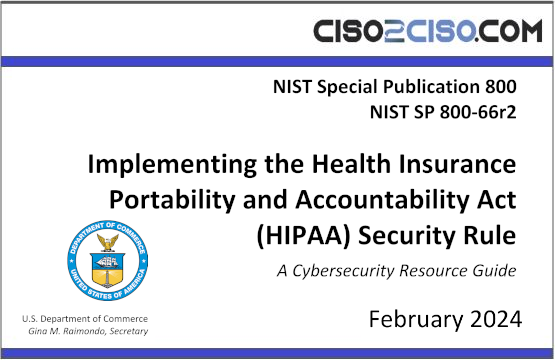This publication aims to help educate readers about the security standards included in the Health Insurance Portability and Accountability Act (HIPAA) Security Rule [Sec. Rule], as amended by the Modifications to the HIPAA Privacy, Security, Enforcement, and Breach Notification Rules Under the Health Information Technology for Economic and Clinical Health Act [HITECH] and the Genetic Information Nondiscrimination Act and Other Modifications to the HIPAA Rules [OMNIBUS], as well as assist regulated entities in their implementation of the Security Rule. It includes a brief overview of the HIPAA Security Rule, provides guidance for regulated entities on assessing and managing risks to electronic protected health information (ePHI), identifies typical activities that a regulated entity might consider implementing as part of an information security program, and lists additional resources that regulated entities may find useful when implementing the Security Rule.
The Security Rule is flexible, scalable, and technology-neutral. For that reason, there is no one single compliance approach that will work for all regulated entities. This publication presents guidance that entities can utilize in whole or in part to help improve their cybersecurity posture and assist with achieving compliance with the Security Rule.
The HIPAA Security Rule specifically focuses on safeguarding the confidentiality, integrity, and availability of ePHI. All HIPAA-regulated entities must comply with the requirements of the Security Rule. The ePHI that a regulated entity creates, receives, maintains, or transmits must be protected against reasonably anticipated threats, hazards, and impermissible uses and/or disclosures. In general, the requirements, standards, and implementation specifications of the Security Rule apply to the following regulated entities:
- Covered Healthcare Providers – Any provider of medical or other health services or supplies who transmits any health information in electronic form in connection with a transaction for which the U.S. Department of Health and Human Services (HHS) has adopted a standard.
- Health Plans Any individual or group plan that provides or pays the cost of medical care (e.g., a health insurance issuer and the Medicare and Medicaid programs).
- Healthcare Clearinghouses A public or private entity that processes another entity’s healthcare transactions from a standard format to a non-standard format or vice versa.
- Business Associate A person or entity that performs certain functions or activities that involve the use or disclosure of protected health information on behalf of or provides services to a covered entity. A business associate is liable for their own HIPAA violations.
The Security Rule is separated into six main sections that each include several standards that a regulated entity must meet. Many of the standards contain implementation specifications. An implementation specification is a more detailed description of the method or approach that regulated entities can use to meet a particular standard. Implementation specifications are either required or addressable. Regulated entities must comply with required implementation specifications. Regulated entities must perform an assessment to determine whether each addressable implementation specification is a reasonable and appropriate safeguard to implement in the regulated entity’s environment.
The assessment, analysis, and management of risk to ePHI provide the foundation for a regulated entity’s Security Rule compliance efforts and the protection of ePHI. Readers are reminded of the Security Rule’s flexibility of approach. The HHS Office for Civil Rights (OCR) does not prescribe any particular risk assessment or risk management methodology. Section 3 and Sec. 4 provide background information about risk assessment and risk management processes, respectively, as well as approaches that regulated entities may choose to use in assessing and managing risk to ePHI.
Many regulated entities may benefit from more specific guidance concerning how to comply with the standards and implementation specifications of the Security Rule. To that end, Sec. 5 highlights considerations for a regulated entity when implementing the Security Rule. Key activities, descriptions, and sample questions are provided for each standard. The key activities suggest actions that are often associated with the security functions suggested by that standard. Many of these key activities are often included in a robust security program and may be useful to regulated entities. The descriptions provide expanded explanations about each of the key activities and the types of activities that a regulated entity may pursue when implementing the standard. The sample questions are a non-exhaustive list of questions that a regulated entity may ask itself to determine whether the standard has been adequately implemented.
Regulated entities may implement the Security Rule more effectively if they are shown controls catalogs and cybersecurity activities that align with each standard. To assist regulated entities, this publication includes mappings of the Security Rule’s standards and implementation specifications to Cybersecurity Framework [NIST CSF] Subcategories and applicable security controls detailed in NIST Special Publication (SP) 800-53r5 (Revision 5), Security and Privacy Controls for Information Systems and Organizations [SP 800-53]. The mapping also lists additional NIST publications relevant to each Security Rule standard. Readers may draw upon these NIST publications and mappings for assistance in implementing the Security Rule.
Additionally, Appendix F links to a wide variety of resources (e.g., guidance, templates, tools) that regulated entities may find useful for complying with the Security Rule and improving the security posture of their organizations. For ease of use, the resources are organized by topic. Regulated entities could consult these resources when they need additional information or guidance about a particular topic.
Views: 3




















































